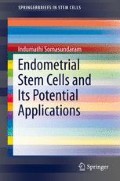Abstract
Endometrial stem cells are already known for its higher proliferation, differentiation, ability to undergo fast angiogenesis during menstruation, and immune tolerance for embryo during pregnancy. Thus, they are considered as a valuable source of stem cells. Several researches have demonstrated the multi-differentiation potency of endometrial MSCs both in vitro and in vivo. They had demonstrated to differentiate into various cell types such as insulin producing cells, osteoblasts, neurons, myoblast, and chondrocytes, which are detailed in earlier chapters. Besides, pre-clinical and clinical experimental trial and therapies had also become successful in treating various diseases such as myocardial infarction, stroke, Parkinson’s disease, and diabetes as discussed earlier. However, on the other side of the coin, it possesses a threat to us by means of causing several gynecological disorders due to its abnormal proliferation and differentiation. It is postulated that several gynecological conditions are associated with abnormal endometrial proliferation, and it is possible that putative endometrial stem/progenitor cells may play a role in the pathophysiology of diseases such as endometriosis, endometrial hyperplasia, endometrial cancer, and adenomyosis (Fig. 4.1). Alterations in the number, function, regulation, and location of epithelial/stromal endometrial stem/progenitor cells may be responsible for any one of these endometrial diseases. Furthermore, study of the clinical correlations of endometrial stem cells with gynecological diseases may unravel several unresolved barriers and lead to the use of endometrial stem cells as an ideal alternative source of curative therapeutics. Thus, addressing this barrier would be a great challenge and beneficial for the womankind. The following section will address the role of endometrial stem cells in causing endometrial disorders such as endometriosis, adenomyosis, endometrial hyperplasia, and endometrial carcinoma. Therefore, endometrial stem cells could be considered as “dual role payer” or a “double-edged sword”; wherein, on one side, it plays a dynamic role in natural function of endometrium, on the other side, it contributes to the pathogenesis of various endometrial disorders through its abnormal proliferation and differentiation.
Access this chapter
Tax calculation will be finalised at checkout
Purchases are for personal use only
Author information
Authors and Affiliations
Rights and permissions
Copyright information
© 2016 Springer India
About this chapter
Cite this chapter
Somasundaram, I. (2016). Threats and Challenges of Endometrial Stem Cells. In: Endometrial Stem Cells and Its Potential Applications. SpringerBriefs in Stem Cells. Springer, New Delhi. https://doi.org/10.1007/978-81-322-2746-5_4
Download citation
DOI: https://doi.org/10.1007/978-81-322-2746-5_4
Published:
Publisher Name: Springer, New Delhi
Print ISBN: 978-81-322-2744-1
Online ISBN: 978-81-322-2746-5
eBook Packages: Biomedical and Life SciencesBiomedical and Life Sciences (R0)

